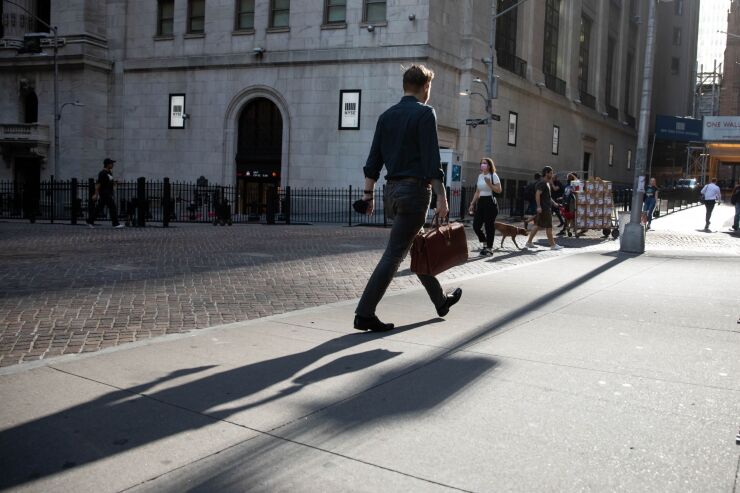(Bloomberg) -- A little-watched corner of Canada's credit market is being shaken up by the country's largest lenders as they pile into securities that shift credit risks to other investors — a play likely to be copied by their counterparts on Wall Street.
Canada's 'Big Five' have quickly ramped up the use of synthetic risk-transfer tools, which allow them to partly pass the risk of loans going sour to private investors. The push comes as they face tougher regulatory requirements on capital buffers.
Exposure to synthetic securitizations has more than doubled over the last two years, swelling to C$86.6 billion ($64.2 billion) at the end of the last financial year, from C$40.3 billion in 2022, according to data compiled by Bloomberg. In the last year alone, this has become a trade that Canada's five largest lenders have joined in on, versus just a single player in the past, namely Bank of Montreal.
The surge in activity underscores how banks are tackling new rules that require them to hold more capital. US banks face billions of dollars more in capital measures under a set of rules known as Basel Endgame, while Canadian regulators have already enforced many of those changes and implemented two additional hikes to the largest banks' capital requirements, beginning in late 2022.
"Synthetic securitization can become an essential part of bank activity," said Robert Smalley, a financials credit desk analyst at UBS Group AG. "It certainly will be for US banks as they look to incorporate the final Basel requirements."
Representatives for BMO, Canadian Imperial Bank of Commerce and Toronto-Dominion Bank confirmed their synthetic securitization exposures, while representatives for Bank of Nova Scotia and Royal Bank of Canada declined to comment.
It's only logical that Canadian banks are major participants in the recent wave of synthetic securitizations, said Smalley, citing the confluence of increasing domestic and international capital requirements.
And with rules around capital floors likely to increase in the coming years, Canadian banks are expected to use synthetic risk transfers even more in the future, according to Scotiabank global equity research analysts Meny Grauman and Felix Fang.
"We believe it is reasonable to expect these numbers to grow as we head into F2026 and beyond," they wrote in a January note to clients.
Securitization Spree
Lenders use the securitizations — also known as credit, synthetic or significant risk transfers — to prop up their regulatory ratios of capital to risk-weighted assets without having to issue capital instruments like equity. They slice reference assets into tranches and generally pass on about a tenth — typically the riskiest parts — to private investors.
This way, they're able to slow the growth of their risk-weighted assets and also lower provisioning — the amount of funds needed to cover losses from soured loans — said Himanshu Bakshi, a credit analyst with Bloomberg Intelligence.
Bank of Montreal has deployed these types of transfers for years. The lender noticeably cranked up its exposure in 2022 and 2023, largely because of its acquisition of San Francisco-based Bank of the West, said Bakshi.
The $16.3 billion deal, which closed last February, would have inflated Bank of Montreal's risk-weighted assets, Bakshi said. Bank of Montreal's asset quality is also weaker than its Canadian peers on a relative basis, he added, noting that it is still strong enough to do these deals in the first place.
Other Canadian lenders like Bank of Nova Scotia sounded out investors last year for inaugural synthetic note offerings, amid the highest interest rates in 22 years.
Bank of Nova Scotia recently hired a banker from Bank of Montreal's desk in charge of structuring synthetic risk transfers, known as SRTs, that help banks rebuild capital reserves. Raad Hossain will join Scotiabank as a director for structured products in the fixed income, currencies and commodities group, according to people familiar with the matter.
'RWA Diet'
In the US, private equity and hedge fund firms are preparing to buy synthetic securitizations by banks after interest-rate increases left lenders with unrealized losses. Issuance in the world's largest economy is "poised for dramatic expansion," specialist investor Seer Capital Management wrote in a January note, with regional lenders also expected to join the fray.
Last September, the Federal Reserve responded to frequently asked questions with guidance on what types of transactions could be eligible for capital relief. Passing on the risk of loans to a special purpose vehicle, which would then sell credit-linked notes to investors, can count as a synthetic securitization. Banks can also issue credit-linked notes directly but will have to ask for the Fed's "reservation of authority" if they are to count toward capital relief.
Fed officials have since fielded several requests by banks to treat the issuance of certain credit-linked notes as synthetic securitizations. "Many US banks have put themselves on an 'RWA diet' until questions around capital requirements are finalized," said Smalley. "As a result, these banks will look to mitigate risk in the most efficient ways available."
Lenders that quickly develop expertise will further monetize by providing structuring, advisory and distribution services to mid-sized and smaller banks, Smalley added.
"Given the size of the economy and banking system, US issuance is likely to dwarf the current market and create a multitude of compelling investment opportunities to complement growing European and Canadian bank issuance," Seer said.
--With assistance from Esteban Duarte.
(Updates with detail on banker hiring in 15th paragraph. A previous version corrected the 2023 securitization exposure figure in third paragraph.)
More stories like this are available on
bloomberg.com






